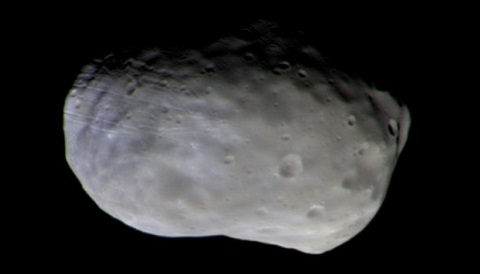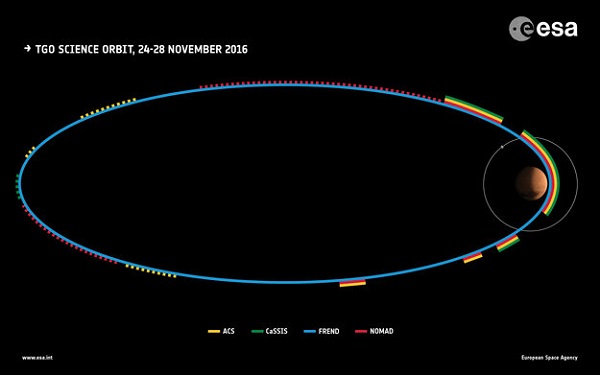Welcome to Mars: the European Space Agency's ExoMars Trace Gas Orbiter sets up shop around the Red Planet.

ESA / Roscosmos / CaSSIS
There has been lots of news out of the ExoMars program in the past few weeks, including first views of Mars (and Phobos!) from the Trace Gas Orbiter (TGO), successful testing of a new NASA relay radio, as well as approval of crucial funding for the future ExoMars rover.
“We are extremely happy and proud to see that all the instruments are working well in the Mars environment,” says project scientist Håkan Svedhem (ESA) in a recent press release. “This first impression gives a fantastic preview of what's to come when we start collecting data for real at the end of next year.”
Latest Phobos Views
As the ExoMars Trace Gas Orbiter calibrated its instruments on two looping passes of the Red Planet, spanning November 20th to the 28th, it also caught sight of another world: the innermost Martian moon Phobos. The Color and Surface Stereo Imaging System (CaSSIS) camera imaged Phobos from a distance of 4,800 miles (7,700 kilometers) on November 26th. Orbiting just 3,700 miles above the surface of Mars and measuring just 17 miles along its longest axis, groove-covered Phobos is most likely a captured asteroid. Orbiting Mars once every 7 hours and 40 minutes – closer than any other moon in the solar system — Phobos will probably crash into the planet some 30-50 million years from now.
The Mariner, Viking, Mars Reconnaissance Orbiter, and Mars Express missions have also looked at Phobos up close. No mission has landed on Phobos as of yet, though Russia did attempt to send the ill-fated Phobos-Grunt sample return mission to the tiny moon in late 2011.
Settling Into Orbit
“This was just a 'toes-in-the-water' type exercise,” says project scientist Jorge Vago (ESA). “Over two orbits we exercised all instruments and acquired some data and calibration results. The coming year we will dedicate to slowly aerobrake the Trace Gas Orbiter into its circular, science orbit.”

ESA
The current elliptical orbit of the ExoMars Trace Gas Orbiter takes it around the Red Planet every 4.2 days, from a close periapsis pass less than 200 miles above the Martian surface out to a distant apoapsis of 60,900 miles. In keeping with Kepler's 2nd law of orbital motion, TGO spends most of its time near apoapsis, while the crucial close in passes of Mars are fleeting.
The ExoMars mission will continue to perform checkout demonstrations of its instruments on each successive pass before settling down into its final near-circular science orbit around Mars just 250 miles above the surface late next year.
The main goal of TGO is to make accurate measurements of rare gases that constitute less than 1% of the tenuous Martian atmosphere, including acetylene, nitrogen dioxide, water vapor and, crucially, methane. The anomalous seasonal source of methane in the Martian atmosphere is controversial, as its source could be geological processes at work or (just maybe) life.
Radio Relays for Future Mars Exploration
NASA also has instruments aboard the orbiter. The twin Electra UHF radios aboard the spacecraft were successfully used to relay data from the Curiosity and Opportunity rovers during a recent periapsis pass on November 22nd. The ExoMars orbiter thus joins NASA's aging Mars Odyssey, Mars Reconnaissance Orbiter (MRO), and MAVEN, along with ESA's Mars Express, in the growing network of orbital relays circling the Red Planet. MRO, MAVEN, and Curiosity already employ Electra hardware, though the new orbiter's package is expected to provide double the relay performance capability compared to MRO.

ESA / Roscosmos / ExoMars / CaSSIS / UniBE
India's Mars Orbiter Mission also entered orbit on September 24, 2014, and rounds out the orbital roll call around the Red Planet. Earthlings (or at least their robots) will continue their invasion of Mars in the coming years, as NASA's Mars Insight makes the journey during the 2018 opposition season, and the United Arab Emirates' Mars Hope, NASA's 2020 Mars rover, and ESA's ExoMars rover make the trip in 2020.
Meanwhile, some good news for ExoMars arrived recently back at Earth, as the joint ESA-Roscosmos mission received the 436 million Euros ($464 million) needed to complete the ExoMars project, including its rover set to launch in 2018. The recent failure of the Schiaparelli Entry, Descent and landing Module on October 19th left the future of the project's rover in doubt.
ESA officials were careful to stress that Schiaparelli was a demonstrator only, and lessons learned will be applied to the rover landing. Findings from the Alenia Aerospace team investigating the crash of Schiaparelli suggest that it may have experienced a '1 second of terror' error in its telemetry and, – thinking it was already on the surface — cut off its engines prematurely, plummeting at 300 kilometers per hour from a height of two to four kilometers to the Martian surface, creating a brand new Martian crater.
But such is the triumph and tragedy of Mars exploration. Expect more great views of Mars to come from the ExoMars Trace Gas Orbiter.
 0
0









Comments
You must be logged in to post a comment.